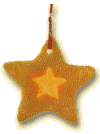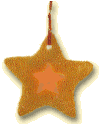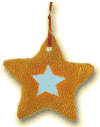
Stars are Not All White!



|
Make these yummy star cookies with genuine star-colored centers you can see through. Suggestion: Find a grown-up to do this with you. Materials:
Follow the recipe and enjoy your stars! |

Stars are Not All White!



|
Make these yummy star cookies with genuine star-colored centers you can see through. Suggestion: Find a grown-up to do this with you. Materials:
Follow the recipe and enjoy your stars! |
|
What Colors are the Stars REALLY? |
|||
|
When you look up at the night sky, you may think the stars look like little white lights. But look more carefully and you will see that some of them are bluish, some are reddish, and some are yellowish. A star's color tells us how hot or cold it is. The bluish stars are the hottest ones. The reddish stars are the coolest, although still plenty hot! If you have a gas stove at home, you may have noticed that the bottom part of the flame is blue, and the tip of the flame is orange or yellow. That is because the bottom part of the flame is burning hotter than the top part. Our sun is a yellow star--not too hot and not too cold. If it were white or blue or red, we probably wouldn't be able to live here! |
|
||
|
Stars are NOT Star-shaped Either! |
|
|
|
Somehow, a long time ago, people started drawing shapes with five or six (or more) points to represent stars. They probably drew them this way because stars look kind of "pointy" or twinkly to our eyes. When starlight passes through Earth's atmosphere, the moving air makes the light rays travel at just a little bit different speeds, so the stars appear to wiggle.
|
|
But stars are really spherical like our own star, the sun. |
|
|
Looking for Life in All the Right Places
|
|
|
But where to look? A good place to start might be a star like our sun, with a planet like our earth going around it. Well, there are lots of stars like our sun, but planets are hard to find. It's like staring at a car's headlight at night -- it's really hard to see much else! |
|
|
|
|
|
SIM is an unusual-looking telescope that uses a clever arrangement of several small mirrors to focus starlight onto a camera. Looking for other stars (besides our sun) with planets like our Earth is one way we might someday discover life elsewhere in the universe! |
|
Dr. Marc likes stars so much he can't bring himself to eat one! |
|
|
|
|||||